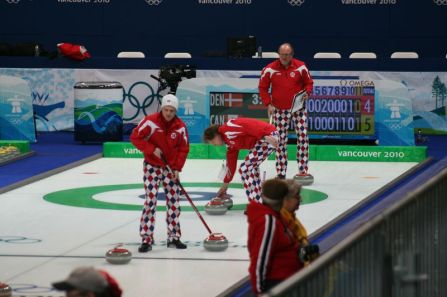There is no shortage of things to love about the great sport of curling. For starters, go take a look at the terrific uniforms of team Norway. It does not get much better than that.
I first encountered curling while watching the Turin, Italy Winter Olympics in 2006, and will fully admit to being a novice. It seemed silly in the beginning. How could this be a sport? Throwing rocks down some ice? Who came up with this? But, the more I watched, the more I came to enjoy it. It is fascinating.
Wikipedia states that curling features two teams of four players that slide stones across ice towards a target area that looks like a bulls-eye. The four-member team consists of the thrower, the two sweepers and the skip, who gives instructions to the thrower and the sweepers. Each team has eight stones and scores points by resting those stones closest to the center of the target, called the “house,” at the conclusion of each “end.” The team with the most points after 10 ends is the winner.
This piece should probably go farther in attempting to teach the intricacies of curling but, at least for me, part of the fun of curling is the unknown. Just as watching more curling grew my affection for the sport, I also learn more each time I watch. There is nothing quite like attempting to learn a sport’s rules by watching it being played, and curling makes the best use of that idea.
Curling’s nickname is “Chess on Ice,” and that is yet another reason I love it. The game is full of strategy and tactics. Each shot is much more complex than simply aiming for the center of the house. Players have to anticipate the shots of the other team and “guard” their stones. They have to set up their next shot and try to outthink their opponent.
This of course leads to a great deal of chatter between teammates. The team’s strategizing makes curling even more fun to watch, as players are constantly talking to each other. Curling fans are treated to a look into the players’ heads, more so than in any other sport.
One of the fun parts of that strategy is curling’s use of the term “the hammer.” The hammer is the name given to the last stone of each end, and controlling the hammer is crucial to a team’s victory. This leads to a great deal of analysis and commentators saying things like “that’s a great shot, but Russia still controls the hammer.” What a terrific term. Let’s get rid of “last licks” and bring “the hammer” to America’s pastime.
Also interesting is that this strategy is almost entirely player driven. In the Olympics, teams are allotted just one timeout, and that is one of the few times coaches are permitted to talk to players. The insignificance of the coaches is another unique feature of curling. The players have to talk to each other, and more often than not, they shout those conversations.
The most easily distinguishable aspect of curling is how the players yell while throwing stones down the ice. Shouts of “sweep!” or “whoa!” echo throughout each of the game’s 10 ends. The player yelling directions, the skip, creates great theater, especially at the Olympics. Hearing “sweep!” in a Russian or British accent never gets old.
If all this is not enough to make you want to grab the nearest curling stone and start sweeping, consider this: in curling, far more than in other sports, sportsmanship is prized. “The spirit of curling” is very important to the game. There is no trash talk, and each game begins with the players shaking hands and using the traditional greeting of “good curling.”
Another excellent tradition is known as “broomstacking,” in which the losing team buys the winners a drink. Terrific uniforms, chess on ice, the hammer and broomstacking. What more could you want?





